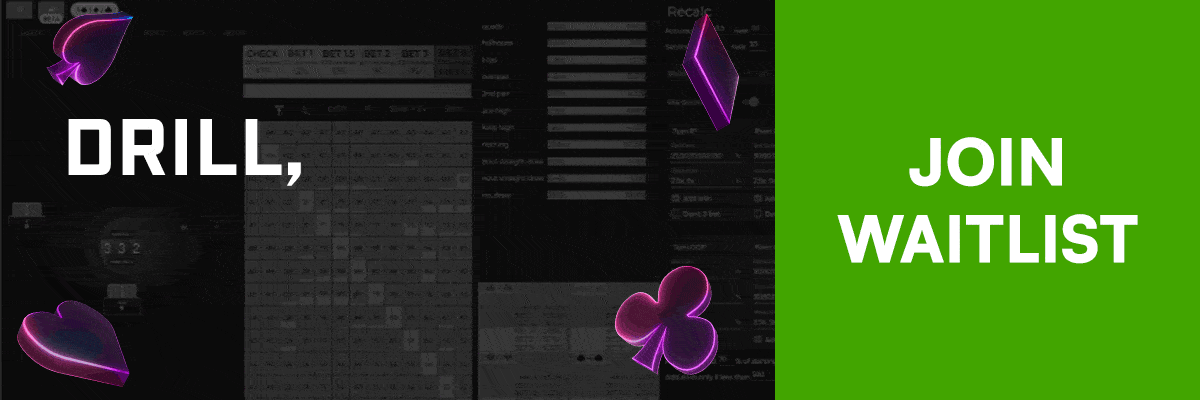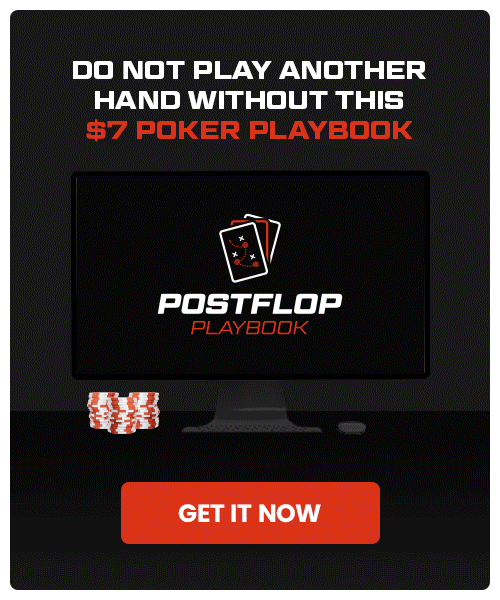How to Win More Pots with Delayed C-Bets
Every skilled poker player has the c-bet (short for “continuation bet”) in their arsenal.
C-betting is an effective strategy because it capitalizes on two crucial factors:
- The preflop aggressor usually has the strongest range of any player in the hand.
- It’s hard to connect with the flop. (The chance of flopping a pair with any non-paired hand in Texas Hold’em is only 32.43%.)
But c-betting has become a victim of its own success. Many players c-bet excessively on certain flop textures, which can be exploited with aggressive check-raises and floats.
So, how can you prevent yourself from c-betting too often while also capitalizing on your advantage as the preflop raiser?
One answer: delayed c-bets.
Here is what you’re about to learn (click to jump to that section):
What is a Delayed C-Bet?
Delayed c-bets are when the preflop aggressor bets after the action checked through on the previous street(s).
For example, you raise on the button and the big blind calls. The big blind checks on the flop and you check back. On the turn, if the big blind checks again and you bet, you’re delay c-betting.
It’s an underused and often misunderstood strategy, and doing so with both made hands, draws, and bluffs will allow you to win more pots and avoid some tough spots.
The Benefits of Delayed C-Bets
Working delayed c-bets into your game will have a number of benefits, including:
- Strengthening Your Checking Range
Checking back with some decent hands keeps your checking range strong and adequately protected. In other words, by checking with some good hands, you prevent your opponents from exploiting you with an aggressive probing strategy.
- Prevents You From C-Betting Too Wide
As mentioned above, many players c-bet at almost every opportunity just because they have the betting initiative, which is exploitable on certain board textures. Delay c-betting with a portion of your range will prevent your flop c-betting range from becoming saturated with too many bluffs and/or marginal hands.
- Can Make Bluffing More Effective
When your opponent calls a c-bet on the flop, their range narrows, meaning you will be up against an overall stronger range on the turn. On the other hand, when you pass up on a flop c-bet and the action checks through, ranges are wider and therefore weaker on the turn.
Being up against a weaker range makes delayed c-betting with your bluffs more effective. This is especially true when you are in position because your opponent has checked twice.
When your opponent has shown weakness twice, you can be more confident with your bluffs. You will likely find that players fold to your delayed c-bets far more often than your c-bets.
Note: Do not play another hand without this $7 Postflop Playbook! With such a low price tag, Doug Polk’s Postflop Playbook is a no-brainer buy if you want to nail down your fundamentals and build a bigger bankroll. Level-up your poker skills now!
Here are three common situations in which you should consider a delayed c-bet rather than a c-bet.
1. When Your Hand Cannot Comfortably Bet Three Streets for Value
When you have a made hand that is not strong enough to bet all three streets for value, consider delaying your c-bet. You should mainly do this when your hand is unlikely to be outdrawn by the hands your opponent will fold on the flop.
For example:
$0.50/$1 Cash Game. 100BB Effective Stacks
Hero is dealt on the button
Hero raises to $3. Villain calls from the big blind.
Flop ($6.50)
Villain checks.
In this flop spot, Hero’s hand is:
- Not strong enough to bet three streets for value.
- Way ahead of the range of hands that Villain will fold to a flop c-bet.
Additionally, checking back with hands like this makes Hero’s check back range stronger, allowing her to better defend against turn bets. For these reasons, Hero can check the flop with the intention of extracting value (or bluff-catching versus bets) on later streets.
When you have a made hand that is vulnerable to being outdrawn on a dry flop — like on 7-3-2 — you should lean towards c-betting on the flop to deny equity. Such bets will force your opponent to fold unpaired hands that could catch up on the turn, which is win when you’re holding such a vulnerable hand.
2. When Your Super Strong Hand Blocks Your Opponent’s Strong Hands
When you flop a super strong hand on a dry board, consider using a delayed c-bet. For example:
100NL Cash Game. 100BB Effective Stacks
Hero is dealt in the cutoff
Hero raises to $3. Villain calls from the big blind.
Flop ($6.50)
Villain checks.
Hero’s top set blocks most of Villain’s strong hands on this very dry board, so checking makes sense. When Hero checks, Villain will have a chance to bet on the turn as a bluff or because he hit something.
Also, Villain is unlikely to check-raise — a dream scenario for Hero’s top set — on this dry board. If the board was more coordinated (like ), betting with top set would be a more attractive option.
3. When You Have a Mediocre Hand on a Wet Board
If you c-bet with too many marginal hands on wet flops, your opponent can exploit you with an aggressive check-raising strategy. You simply won’t have a strong enough range to defend effectively.
I’m talking about a hand like on a flop. Take a look at this screenshot from Upswing Poker’s upcoming tool (the Lucid GTO Trainer):
Ten-Seven suited almost always checks back on this wet 7-6-5 flop. Though it is interesting to note that the solver chooses to bet a bit more often when it has a backdoor flush draw to go with the top pair.
You can prevent being exploited by c-betting only when you hold strong hands or hands that you don’t mind folding versus a check-raise. With a mediocre made hand, delay your c-bet until the turn or river.
Note: Want to be one of the first players to leverage the Lucid GTO Trainer to gain an edge on opponents? Join the waitlist here and keep an eye on your inbox for news about the launch very soon!
Delayed C-Betting Examples – Unique 3-Bet Pot, Multiway and Live Poker Situations
Now let’s dive into member-submitted hand histories with strategic commentary courtesy of Ryan Fee.
These aren’t simple heads-up pots. All 3 of these examples have some unique stuff going on that you might come across in your games.
Example #1: Delayed C-Betting in a 3-Bet Pot
This hand was submitted by an anonymous Lab member.
Online Cash 4-Handed. 100BB Effective Stacks.
Hero is dealt in the big blind
Button raises to 2.5bb. Hero 3-bets to 12.5bb. Button calls.
Flop (25bb):
Hero checks. Button checks.
Turn (25bb):
Hero bets 23bb. Button calls.
River (71.5bb):
Hero goes all-in for 64.5bb. Button folds.
It definitely makes sense to use as a delayed c-bet on this board, at least some of the time. It does do a good job blocking some of the button’s strong hands (KJ/QJ), but there are many other hands in our range that are more effective c-bet bluffs.
Specifically, there are many hands that have less showdown value and more playability on future streets than . These include flush draws, straight draws, some backdoor draws, and even our KQ combos that have a backdoor flush draw.
Going for a mixed frequency c-bet on the flop with would be a decent play here, which I’m quite sure a solver would confirm. That said, it’s fine to simplify your strategy and check every time.
Editor’s note: The screenshot below from Lucid GTO confirms that is a mixed frequency check by solvers on the flop.
On the turn, some hands that should have checked on the flop will now be slam-dunk turn value bets (like JJ, TT, JT, QJ and the occasional slow-played overpairs). We also need to delay c-bet with bluffs in order to balance our range; using makes sense because it has two overcards and turned a draw to the nuts.
Example #2: Delay C-Betting with a Marginal Value Hand in a Multiway Pot
This hand was submitted by Lab member Igor G.
25NL Cash Game. $25 Effective Stacks.
Hero is dealt in the hijack
Hero raises to $0.75. Cutoff calls. Big blind calls.
Flop ($2.35):
Big blind checks. Hero bets $1.17. Cutoff calls. Big blind calls.
Turn ($5.86):
Big blind checks. Hero bets $2.93. Cutoff calls. Big blind folds.
River ($5.86):
Hero checks. Cutoff checks.
We should not c-bet with this hand on the flop — at least not every time. We have stronger top pairs (AJ+) to value bet here, along with our two-pair and set combos (88, 55, A8s, A5s).
If we c-bet with weaker top pairs as well, we make ourselves vulnerable to flop raises in a multiway pot like this. Betting with AT on the flop could lead to some tricky situations if either opponent raises.
Additionally, keeping in our checking range ensures that we have some relatively strong top pairs when we check. When the action checks through on the flop and the turn is a blank, AT is an easy value bet and a great hand to have in our delayed c-betting range.
With that said, you could make a case for betting on the flop and checking on the turn with this hand. But betting both the flop and turn here is simply too thin.
Example #3: Exploiting Weak Live Players with Delay C-Bets
Upswing member Sam H. posted this hand to the Facebook group.
$2/$5 Live 9-Handed. $400 Effective Stacks.
Hero is dealt in middle position
UTG straddles to $10. Hero raises to $25. UTG calls.
Flop ($57):
UTG checks. Hero checks.
Turn ($57):
UTG checks. Hero checks.
River ($57):
UTG checks. Hero checks.
Since this is a live hand, I’m going to recommend a highly exploitative delayed c-betting strategy that has printed money for me at live tables.
A common tendency of live players is to bet any pair on the turn after the flop has checked through. I think they do it for “protection”, or because they fear facing a turn bet themselves. Either way, this tendency is a massive leak that can be exploited with an aggressive delayed c-betting strategy.
On this board, such opponents would lead on the turn with all of the Ax, Tx and 5x combos in their range. If this is the case, we can delayed c-bet on the turn with an astronomically high success rate. We can also check back more hands that we would normally c-bet on the flop in order to reach this very profitable turn spot more often.
These types of players are most common in live games, but this adjustment will work well against anyone that probe bets too liberally.
Final Thoughts
If you read every word of this article, congrats because you covered a lot of ground in a short time.
To recap the main points:
- Delayed c-betting is when you bet on the turn after passing up a c-bet opportunity on the flop.
- The benefits of delayed c-betting include:
- Strengthening your checking range.
- Keeping your c-bet frequency under control.
- Making your bluffs more effective.
- Situations in which you should delay your c-bet include:
- When your not-so-vulnerable made hand cannot comfortably bet three streets for value.
- When your super strong hand blocks your opponent’s strong hands.
- When you have a mediocre hand on a wet board.
To quiz yourself on this topic, check out [QUIZ] Do You Actually Know When to Delay C-Bet?
Thanks for reading!
When you get The Postflop Playbook, you will learn how to make quick and profitable decisions that translate to more (and bigger) winning poker sessions. Learn more now!
This article has been updated (original publish date October 2017).


